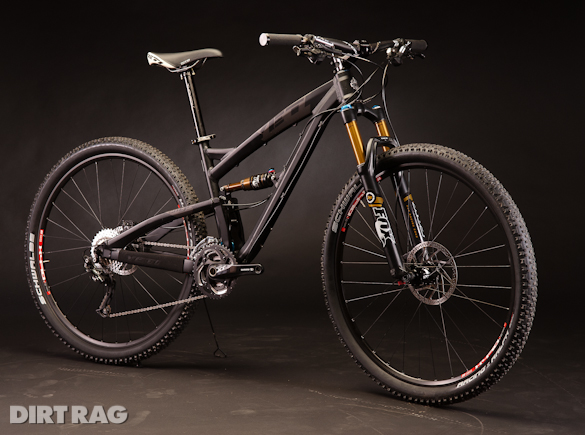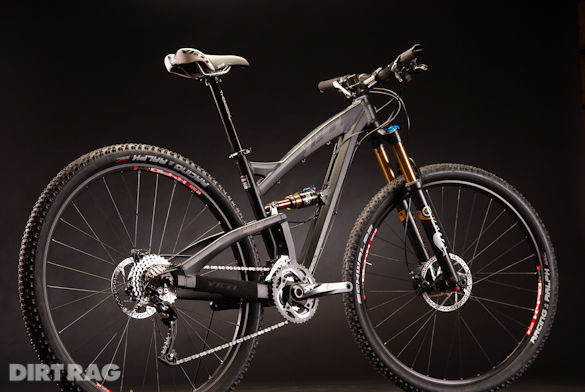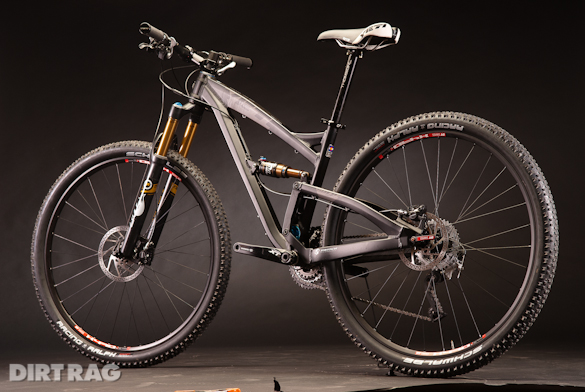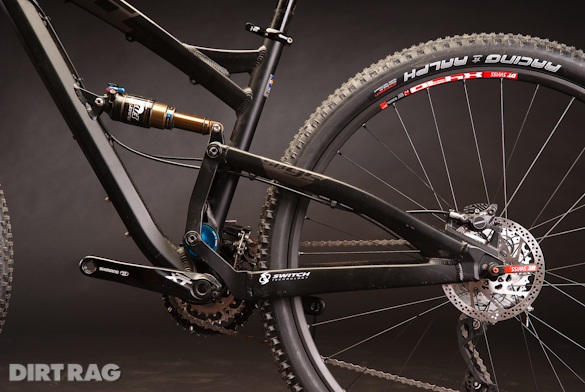Review: Yeti-SB95
Originally posted on April 2, 2014 at 15:33 pm
According to Yeti, “SB” stands for “super bike.” Normally this type of marketing claim makes me skeptical, but I was mightily impressed with the SB-66 and its Switch suspension. Given that, I was itching to see if the 66’s settled chassis, snappy pedaling performance and ready-to-rally spirit translated to Yeti’s big-wheeled trail bike.
Fundamentally, Switch suspension is comprised of an eccentric main pivot that rotates counterclockwise during the first two-thirds of suspension stroke; it then “switches” to rotate clockwise after the inflection point. When pedaling, chain tension resists the eccentric’s rearward motion, providing anti-squat. After the inflection point, suspension action is largely independent of drivetrain forces for a plush end of stroke.
In order to save weight, the eccentric main pivot rotates on one bearing and one bushing, rather than the SB-66’s dual bearing setup. Both SB95s we had for testing developed a subtle creaking at the main pivot, but periodic cleaning of the eccentric helped to keep things quiet.

Yeti endowed the SB95 with a 68.5 degrees head tube angle with the Fox 34 fork set to its stock 120mm of travel, 67.6 degrees when at 140mm. Bottom bracket height varies with fork travel between 13.2 and13.5 inches, while chainstays are a middle-of-the-road 17.5 inches. When compared size-for-size, the SB95 has a shorter wheelbase than its SB-66 counterpart. Perhaps counter intuitive at first, but Yeti is adding stability to the 26-inch bike, while keeping the 29-inch bike nimble. Yeti’s Chris Conroy says, “We wanted it to be a legit trail bike that took into account the riding characteristics of the larger wheels. The slacker head angle makes it handle like a trail bike on the descents, but we opted for a shorter top tube so it’s still playful and quick.”
While the SB-66 has six inches of travel (and 26-inch wheels, thus the “66”) the SB-95 has five inches, roughly 127mm. The SB-66 has shorter chainstays coupled to a longer front-center, while the SB95 is the opposite. As expected, the SB-66 lofts its front wheel with less effort and offers a touch more stability descending steep terrain and at high speeds. The SB95 requires a less committed lean into corners, while the larger wheels provide ample stability, but require more effort to execute dynamic moves.

In stock form, my test bike was set up on the light-duty end of the spectrum: light tires, skinny rims, fork set to 120mm. As such, it rode light and quick, with neutral handling. It wasn’t a stretch to imagine employing this bike for recreational endurance racing or 100-milers given the weight, efficiency of the suspension design and its ability to cover lots of ground with minimal effort.
Later, I swapped the fork over to 140mm and installed burlier wheels and tires: Crankbrothers Iodine wheels, and 2.3-inch tires. Set up tubeless, the whole package added only 92 grams. With those changes, the SB95 transformed from a trail rider to a trail slayer. I loved the bike’s new attitude, and was very impressed with the frame’s ability to keep pace—no flex here. I could easily pummel the SB95 into just about any “trail” riding scenario. The SB95 requires less work than the SB-66 to rally through slow, chunky technical sections, essentially beating the trail beneath you into submission.

In terms of outright pedaling performance, I feel the SB bikes provide one of the most responsive rides currently on the market. I’m a big fan of bikes with a lot of anti-squat: dw-link, Split Pivot, etc. Switch takes it one step further in my experience by delivering even more anti-squat when standing to pedal, providing a nearly bob-free experience. I’d give the nod to the dw-link for outright traction and small bump compliance, but the Switch offers a more responsive feel under power. The balance of a snappy beginning, responsive middle, and a plush and controlled end of stroke is, in my opinion, the best representation of what the modern mountain biker is looking for; the ability to go long and to go big with one bike.
Color me turquoise, ‘cause I’m a convert. The SB-series bikes are simply awesome, maybe even “super.” For the rider who likes to play, the SB-66 is your choice. If you want to cover lots of gnarly ground with minimal exertion, the SB95 is just the ticket. Plus there is a new SB-75 with 27.5 wheels. We’ll have to try one of those next… Stay tuned!

Vital stats
- Geometry (Medium with 120mm fork)
- Top Tube 23.1 inches / 587mm
- Head Angle 68.5 degrees
- Seat tube 72.0 degrees
- Chainstay 17.5 inches / 444.5mm
- Wheelbase 44.9 inches / 1,140mm
- BB height 13.2 inches / 335mm
- Country of Origin: Taiwan
- Price: $6,800 (PRO XTR Build), $2,250 (frame & shock)
- Weight: 28.50 pounds (w/out pedals)
- Sizes Available: S, M (tested), L, XL
